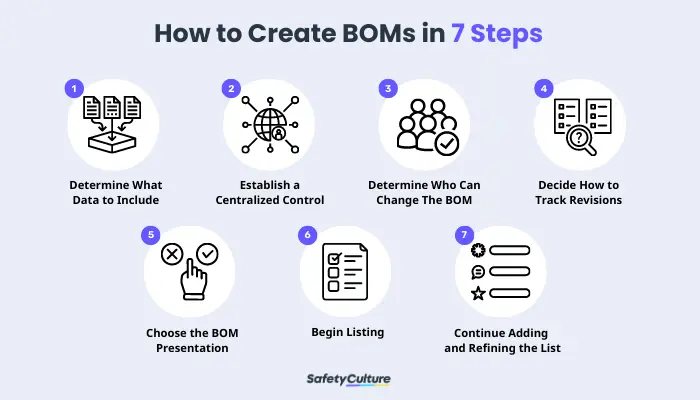What is a Bill of Materials (BOM)?
Bills of Materials, or BOMs, list all the parts and components that go into building a product. In other words, it’s a shopping list for manufacturers. A BOM typically includes a description of each part and information about its price, supplier, and product code.
The goal of a BOM is to provide a complete overview of the materials needed to create a product, making it easy for manufacturers to order the correct parts and assemble them correctly. While BOMs are essential for large-scale manufacturing operations, they can also be helpful for smaller businesses and hobbyists who need to keep track of the parts used in their products.
Who Uses a Bill of Materials?
The bill of materials includes a broad scope of data, so input from various company departments is essential for its construction. These may consist of functions such as design, engineering, purchasing, materials management, and manufacturing.
How can a BOM Benefit You?
A well-crafted bill of materials aids companies in materials requirement planning and manufacturing by providing an accurate and quickly followed roadmap. A good BOM can improve different parts of production, including:
- Planning purchases of raw materials
- Tracking and planning material requirements
- Estimating material costs
- Managing inventory
- Monitoring material shortages
- Avoiding planned and unplanned downtime
- Controlling budget
- Staying on schedule
- Maintaining records
- Reducing and managing waste
- Identifying the cause of a product failure
- Fastly replacing faulty equipment
- Finding vulnerabilities in software components
- Improving supply chain security
What are the Different BOM Structures?
Single-Level Bill of Materials
Single-level BOMs help provides a shopping list, but they have limitations. For example, they do not indicate how assemblies, subassemblies, and components relate to each other.
Multi-level Bill of Materials
A multi-level bill of materials (also called a parent-child BOM) differs from a single-level BOM in that it shows the relationship between components, subassemblies, and assemblies. Material or subassemblies used to make up the higher-level assembly or part are usually indented. As a result, multi-level BOMs are sometimes called indented BOMs.
How to Create an Effective BOM?
BOM records should always include specific product information, such as:
- BOM Level – Numbered BOMs are much easier to follow and understand, showing where each component fits into the larger assembly. It makes it easy for anyone familiar with the structure of a BOM to identify which part goes where.
- Part Number – Designate a specific number for each part or assembly so you can locate and identify them rapidly. It’s typical for manufacturers to elect either an intelligent or non-intelligent numbering system. However, be mindful of creating several numbers for the same component regardless of which scheme you use.
- Part Name – By recording the unique name for each element or assembly, you can identify individual parts faster.
- Phase – Keep a record of which stage in its lifespan each component is at. For instance, it’s usual to use the term “In Production” for currently manufactured parts. New components that are not approved can be listed under “Unreleased” or “In Design.” It becomes useful when you’re at the New Product Introduction (NPI) stage, as it allows you to monitor progress effortlessly and set up achievable project plans.
- Description – To avoid confusion and help with identification, provide a detailed description of each separate part.
- Quantity – By recording the necessary parts for each assembly or subassembly, you can help dictate and streamline purchasing and manufacturing processes.
- Unit of Measure – Be sure to use the exact measurements for all similar types of parts so that there is no confusion about quantities later on. You can use ‘each’ or measures such as inches, feet, ounces, and drops. It’ll streamline the process from procurement to delivery.
- Procurement Type – By detailing how every component is bought or built (for example, from a store shelf or to customer specifications), you can make your manufacturing, planning, and procurement activities more efficient.
- Reference Designators – Adding reference designators to your BOM can help avoid time-consuming confusion and save you money in the long run.
- BOM Notes – Keep everyone interacting with your BOM up-to-date by capturing other relevant notes.
Create Your Own BOM Template
Eliminate manual tasks and streamline your operations.
Get started for FREETypes of Bills of Materials
You can have either a single- or multi-level BOM for use during various stages of product development. The most common types are engineering, sales, and manufacturing BOMs—each with its key focuses.
Engineering Bill of Materials (EBOM)
The EBOM is a product’s design blueprint. It includes everything engineering has designated as needed to assemble the final product, such as items, parts, components, and subassemblies. The BOM generally contains a technical drawing of the desired outcome.
Sales Bill of Materials (SBOM)
SBOMs are simply a list of the products and components in the order that they are needed to create the customer’s product. This bill comes from the sales order and includes final products and any necessary pieces or parts, which will be specified in detail within the sales record.
Manufacturing Bill of Materials (MBOM)
The Manufacturing BOM is a tool used during the production process. It facilitates the identification of shippable products, packaging, and waste items.
How to Create BOMs in 7 Steps
Depending on your industry, different people need to look at the bill of materials to ensure it is correct. Here are several steps involved in making a helpful bill of materials, including:

1. Determine What Data to Include
For example, the BOM might include consumables necessary for the product, like glue or wire. The inclusion of these in the BOM from the beginning ensures smooth production in the future.
2. Establish a Centralized Control of the BOM
Because various departments or functions in an organization usually use different information systems, the BOM (Bill of Materials) will need to be accurate and up-to-date by gathering data from all these separate systems into one primary record.
3. Determine Who Will Be Able to Change The BOM
It is best to have only a few editors so that there are fewer chances for mistakes.
4. Decide How to Track Revisions to The BOM
Although BOMs are revised frequently, every modification must be documented so that the BOM provides value and remains accurate. Ensure that each change can be attributed to its author.
5. Choose the BOM Presentation
Choose between single- or multi-level depending on what’s perfect for the product.
6. Begin Listing
Enlist each material, component, and parts that will make up the product since this is subject to change over time.
7. Continue Adding and Refining the List
As the product changes, so will the BOM. Keep it updated as much as possible to ensure everyone is on the same page.
FAQs About Bill of Materials
A bill of material calculation uses data from several sources to determine a manufactured item’s standard cost. These sources can include information about items, routings for bills, formulas for calculating indirect costs, and the costing version.
A multi-level BOM consists of nested lists of components and assemblies (i.e., hardware, software, PCBAs) within the finished assembly. In contrast, a single-level BOM represents a lower-level assembly (i.e., PCBA).
COGS refers to the total cost of a single unit, including the BOM, labor costs, and shipping. Your gross margin is determined by subtracting your COGS from the sale price. Depending on your distribution channel, your margin will differ. COGS only includes the costs to produce the goods, while the BOM includes all the materials used in production.
The type of suppliers you work with significantly impacts the likelihood of acquiring a BOM. If obtaining a BOM is essential to your business, consider partnering with a contract manufacturer. Even though this requires relinquishing control over product design, it may be manageable depending on your company’s size and capacity.




